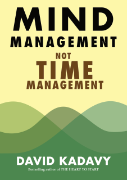Subscribe to blog updates via email »
ActiveCampaign Review 2025: Why I’ve stayed 9 years
ActiveCampaign has been my email marketing platform for nine years. I just paid for another full year up-front, and I’ll probably still be a customer in another nine years.
In this ActiveCampaign review, I’ll tell you what I love, what I don’t love, and what in the past has made me consider switching.
(If you prefer video, watch here.)
ActiveCampaign free trial: 14 days (then 20% off)
If you decide you want to try ActiveCampaign, use this link.
After a 14-day free trial, this will get you 20% off annual plans. I make a commission if you become a paying customer, but I promise to tell you the good and the bad in this review. (Using my link costs you nothing extra.)
Who am I and for what do I use ActiveCampaign?
For background, I’m David Kadavy, and I’m author of books such as Mind Management, Not Time Management. I’ve been using email marketing in my business since 2010, and have over 20,000 active subscribers. I started with MailChimp, but after lots of research I chose ActiveCampaign in 2015, and have been with them ever since.
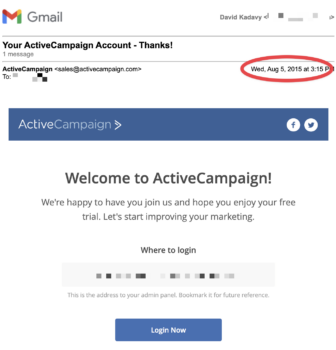
Pros, Questions, and Cons
I’ll divide up this review into three sections: Pros, Questions, and Cons. That is, the things I love about ActiveCampaign, the things that made me consider switching away, and the things I still don’t love.
Pro #1: Upgradeability
One reason I’ve been with ActiveCampaign so long is their upgradeability.
I never know how my business and how I use email marketing will evolve, and no matter how my business changes, I feel confident ActiveCampaign will have an option that fits me.
ActiveCampaign is upgradeable in these ways:
- They have four different levels of service: Starter, Plus, Pro, and Enterprise plans.
- They have add-ons, such as SMS marketing, Enhanced CRM for pipelines and sales engagement, and transactional emails.
This means that:
- If I develop a consulting service with a long sales cycle, I can add-on CRM features, such as Lead Scoring, and AI-powered win probability.
- If I build an app, I can add transactional emails to handle password resets and other critical account-management emails.
I don’t see the following in my future, but others will love that:
- For Enterprise customers, they have a dedicated account manager, uptime SLA agreements, and robust data security features, such as HIPAA compliance.
- White-labeling is great for both Enterprise customers and agency owners. As an Agency Partner, you can give AC your own or your client’s own branding, so it looks like you built it just for them. Enterprises can brand AC to look like internal company software.
Pro #2: Versatility
ActiveCampaign’s upgradeability works hand-in-hand with its versatility. The feature that makes AC the most versatile has always been their drag-and-drop visual editor.
ActiveCampaign’s drag-and-drop visual automation editor is what made me fall in love all those years ago. Many competitors have tried to copy their style.
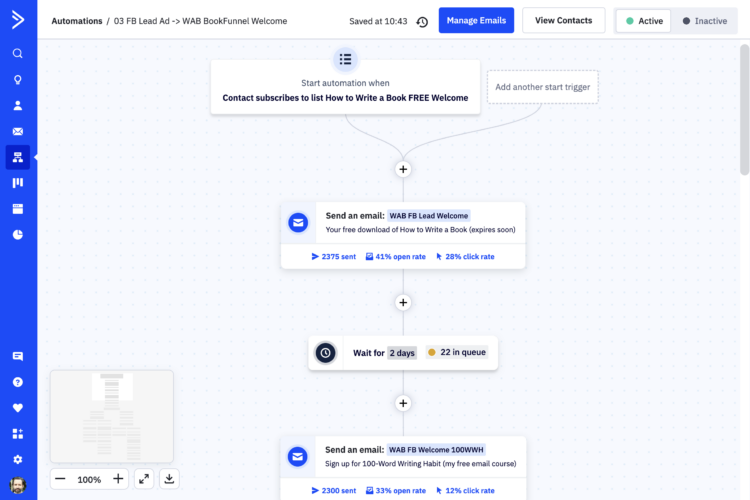
ActiveCampaign’s automations: from recipes to building blocks
ActiveCampaign’s automation builder is like building with LEGO bricks. You can mix and match a ton of building blocks.
You can start with one of hundreds of recipes, organized by industry.
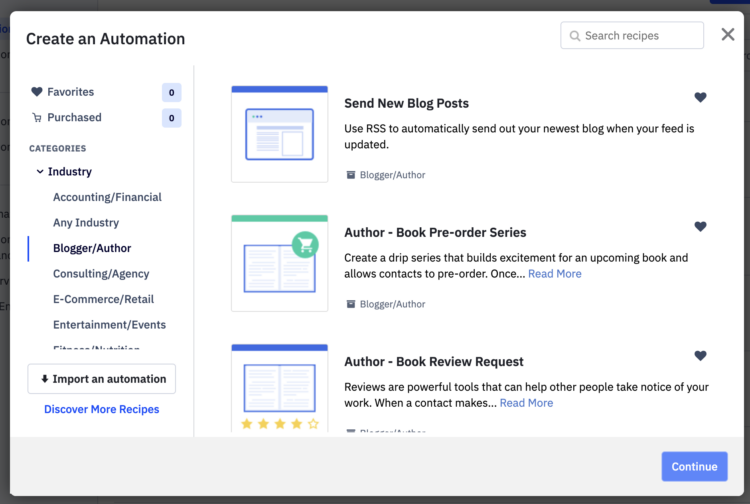
Or, you can start from scratch, building from various elements. For example, there are dozens of triggers from which to start an automation, such as when someone reads and email, visits a web page, or makes a purchase.
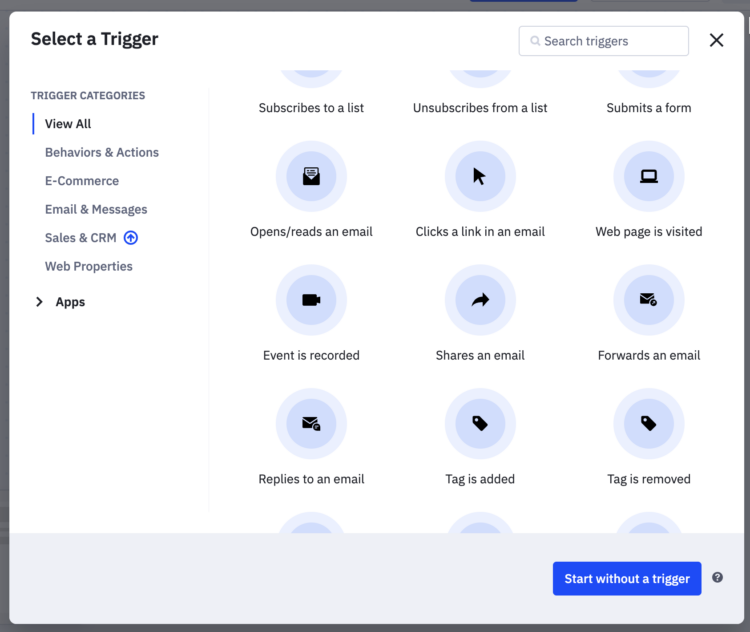
Customers with the pipelines and sales engagement add-on can also use triggers such as a deal’s status changing, after a task is completed (such as signing a contract), or the lead’s sentiment becomes more positive or negative (which is AI powered).
View my actual ActiveCampaign automations
If you’d like to see my actual automations, for running email courses, promoting webinars, delivering lead magnets, warming up paid leads, and re-engaging cold subscribers, watch this section of my video review of ActiveCampaign.
Message Variables
My favorite ActiveCampaign feature has long been Message Variables. These were especially handy when I frequently ran webinars.
I’d simply create a series of variables, such as the price of the product I was promoting on the webinar, or the deadline of my offer, and use them in the emails throughout my automations.
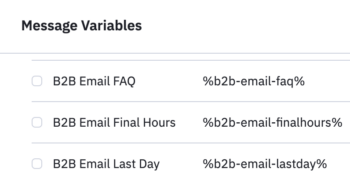
This way, if I wanted to send the same sequence of emails for a future webinar, all I had to do was make a copy of the automation, and edit the variables. The right information would be changed throughout the emails, without having to edit each one and risking making a mistake.
Integrations
You can do a lot with ActiveCampaign on its own, but when you consider all the integrations they have available, you can do just about anything. If there’s a piece of software that’s important to your business, you can be almost sure ActiveCampaign integrates with it.
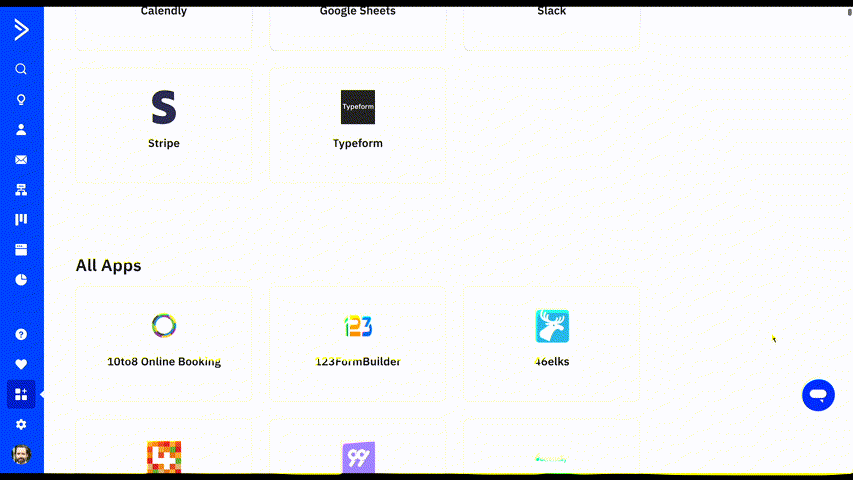
These aren’t puny integrations, either. When I was doing webinars often, AC’s integration with WebinarJam was noticeably more robust than the integrations with other platforms.
If ActiveCampaign doesn’t have a direct integration, or if their integration doesn’t have all the features you need, they also integrate with Zapier.
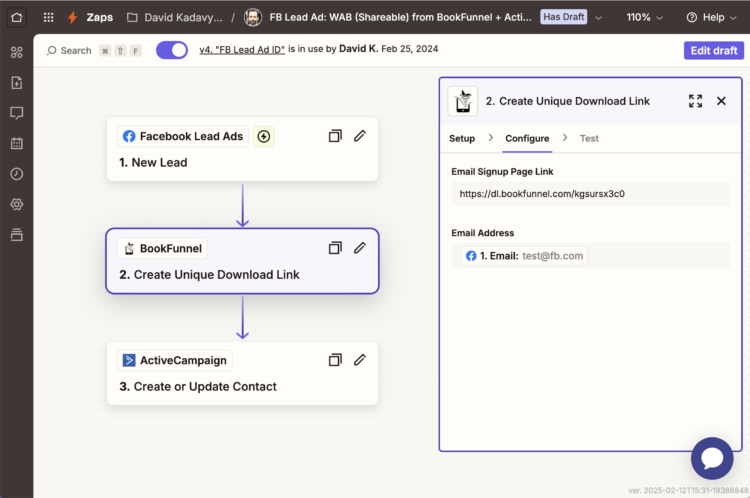
For example, AC integrates with an author tool called BookFunnel, which helps me give away ebooks as a lead magnet. But I use the Zapier integration for the more advanced feature of generating a unique download link for each subscriber.
Pro #3: Robust segmentation
The third and final big “pro” of ActiveCampaign is their segmentation. MailChimp’s limited segmentation options were a big reason I switched nine years ago.
At the time, you couldn’t mix AND and OR operators. So, for example, you could create a segment of customers who had bought an orange widget AND a blue widget, or, you could create a segment of those who had bought an orange widget OR a purple widget, but not those who had bought an orange widget AND a blue widget OR a purple widget. That might not sound like a huge deal but it was a major barrier to doing what I wanted, on a regular basis.
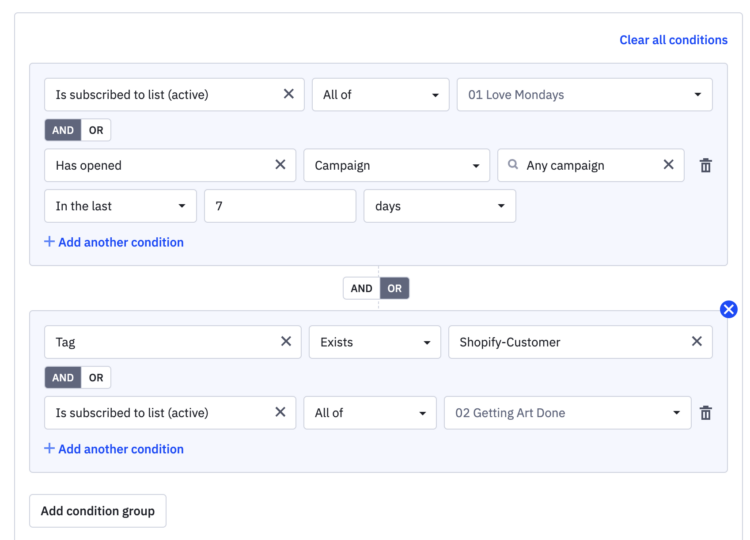
On AC, you can build segments based upon an insane number of variables, including campaign activity, fields you’ve created, website activity, and AI-powered predictive geography, which can be really handy for notifying subscribers of in-person events.
Question 1: RSS support
Admittedly, this is an uncommon issue, but one of the reasons I recently considered switching from AC was their RSS integration.
I embarked on a project last year to send my Love Mondays newsletter by scheduling a post right here on my WordPress blog, which would update an RSS feed, which would trigger a campaign. Kind of like a roll-your-own Substack.
I had a hard time finding good documentation on ActiveCampaign’s RSS support. I could find some, but through running some tests, I realized there were some features that weren’t documented. I wanted to know those so I could build from the RSS feed exactly the email template I imagined. Unfortunately, not even AC’s support team could provide me with more than what was already listed.
So I did some looking around and realized…ActiveCampaign’s RSS support is actually awesome, in comparison. Kit’s (then ConvertKit) could get me close to what I wanted, but it turned out to be impossible to get to a level I found acceptable. Beehiv didn’t have RSS support at all!
Now I have the system I imagined all set up, and it’s saved me a ton of time over the past year. I recall I had to make at least one tiny compromise, but I can’t even remember what that was.
Question 2: Deliverability
I think every email marketer worries their missing out on deliverability. It’s enticing to think that just by switching to another platform, you could boost your open rates, and thus your revenue.
So, I considered switching from ActiveCampaign because I wondered about their deliverability rates.
But for these reasons, I’ve concluded ActiveCampaign’s deliverability is great, if not the best in the business.
- An independent test found ActiveCampaign had the best deliverability.
- By running my own test, I found emails sent from Kit didn’t generate a significantly higher open rate than through ActiveCampaign.
- According to some basic principles of email deliverability, I feel more comfortable that ActiveCampaign will continue to have high deliverability than, say, Kit.
Independent test: ActiveCampaign has the best deliverability
That independent test was through EmailToolTester. They tested across fifteen email marketing platforms, sending to about eighty email addresses across twenty-eight ISPs, to see which got through. Across their three latest tests, ActiveCampaign had the highest deliverability, about 10% higher than average.
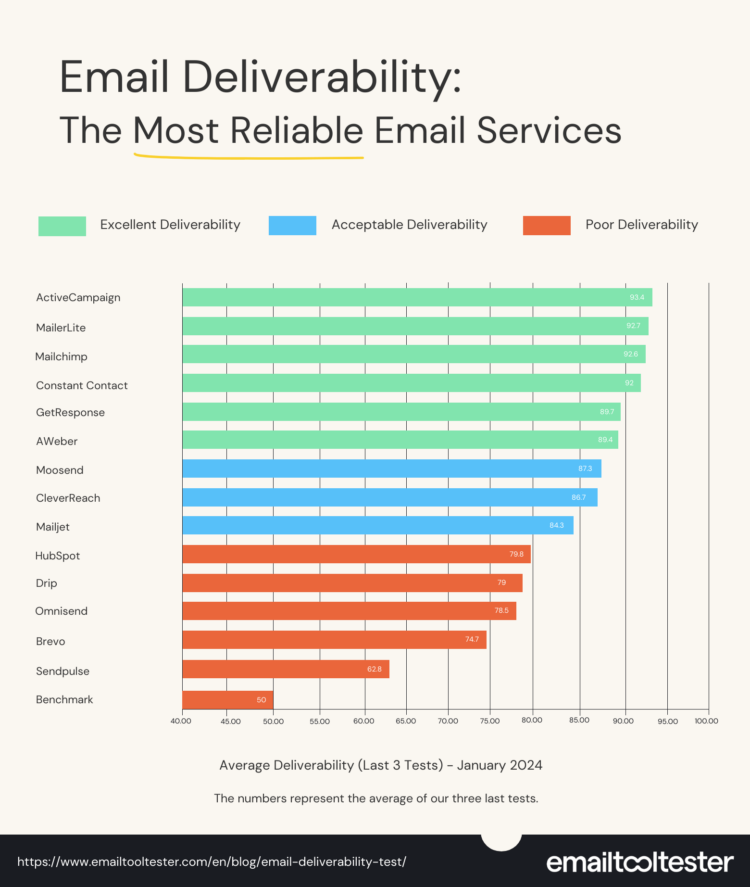
My own test: Kit’s deliverability is no better than ActiveCampaign’s
Kit was not included in EmailToolTester’s latest test, because they didn’t at the time allow DMARC authentication. That’s worrying in itself, but Kit now does have this feature. So I wanted to find out for myself whether I’d have a higher open rate sending through Kit.
So, I created a randomly-selected segment of my subscribers, authenticated my domains with KIt, and sent exact copies of my emails, over the course of a month, through Kit.
On some of the emails, my open rate with AC was slightly higher, on others, my open rate with Kit was slightly higher. The differences I found weren’t significant – certainly not enough to merit a switch.
I share my findings in detail in this video on ActiveCampaign vs. Kit deliverability.
Common sense: ActiveCampaign doesn’t fill your list with irrelevant subscribers
The third reason I concluded ActiveCampaign’s deliverability was as good as I could find anywhere else goes down to common sense about the principles of email deliverability.
Generally, if you send emails to people who don’t really want them, you’ll harm your sender reputation and harm your deliverability.
To explain why that’s relevant to ActiveCampaign, I need to get into the third Question I had about AC that made me consider switching: growth.
Question #3: Growth
An enticing feature of other email marketing platforms is growth features. These usually involve some kind of recommendation system within the platform, wherein the email lists of other creators in the system are promoted alongside related creators.
Kit’s Creator Network is bad for deliverability (probably)
The one I had the most FOMO about was Kit’s. But after digging deeper, that FOMO (Fear of Missing Out) turned into JOMO (Joy of Missing Out).
Because the way Kit’s Creator Network works is by recommending related newsletters when you’re signing up for a newsletter. So when someone signs up for another email list, your list may be included in something like this, as part of that other creator’s sign-up flow.
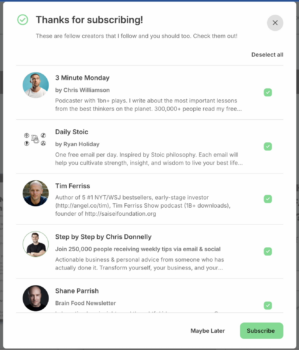
So essentially, people get added to your list because they checked a box while signing up for someone else’s list (or, because they merely didn’t un-check a box).
That just screams unengaged subscribers, and some report just that.
If you’re consistently adding subscribers who just aren’t that into you, as they ignore your emails, or worse yet mark them as spam, your sender reputation will suffer, maybe to the point that people who actually want your emails don’t get them.
If an entire ESP is full of people who are consistently adding unengaged subscribers, that doesn’t bode well for the reputations of their servers.
So this is just speculation, but based upon basic principles of deliverability, I don’t have confidence long-term in Kit’s ability to maintain high deliverability rates.
Substack’s recommendation system is nearly identical, and many users report low deliverability with Substack.
Recommendation networks aren’t magic
Granted, to have unengaged subscribers added to your list, you need to get subscribers in the first place. If you want subscribers from a recommendation network, you will either have to already be quite famous, or strike up partnerships with other creators, to cross-promote your lists.
I am barely famous enough to make a living from my writing. I made a profile in Kit’s Creator Network while testing open rates, and got added to zero networks and gained zero subscribers.
It’s worth noting that Kit is now using an automatic recommendation engine. I’ve noticed a few subscribers trickle in from this during another recent trial period, but looking closely at them, they don’t appear to be real subscribers.
So, how do you grow?
Don’t get me totally wrong here – recommendations are probably a legitimate tactic, among many, to grow your list. But you have to be careful, and most list owners probably are not, and I personally don’t want to be sharing email servers with them.
If I do make a recommendation network a part of my growth strategy, I’ll be sure to aggressively quarantine and warm up any leads I get through this channel before moving them to my main list. You can see how I would go about that when I talk about this automation in my ActiveCampaign review video.
I no longer have FOMO about Kit’s Creator Network, and I’m happy to grow my list through lead magnets, while being careful to warm up new leads, while pruning inactive leads – even if that means paying for ads on Meta or X.
A caveat on “Cons”
Choosing an email marketing platform is a bit like choosing a spouse, or buying a house. It’s an important decision about something very complex. You have to decide what’s really important to you, and if you get that, there might be a few features that are less than ideal, or even drive you crazy.
Ultimately, you have to make a commitment and decide to be happy.
Here are some of the “cons” of ActiveCampaign, and why I’ve decided to stick with them anyway.
Con #1: Support
The first con of ActiveCampaign is support. It’s not that their support is slow or bad, but when I tried out Kit, their support was more responsive, friendlier, and communicated better.
That, for me, doesn’t ultimately make one better than the other. I’m an advanced user, and know how to look up support docs and troubleshoot things on my own. If I’m contacting support, it usually means the issue isn’t covered in the public support docs – the same ones the support team has access to – or something is just broken.
So having really responsive and friendly support agents doesn’t do me any good if they only know what I can already find. In my experiences with Kit’s support team, I didn’t find them to be more technically adept than the team at ActiveCampaign.
One thing that will be changing by the day is how support teams leverage AI. Just a few days ago, I contacted AC’s support, and immediately got back an excellent AI-generated response, which fixed my problem.
Con #2: The campaign editor
What I like least about ActiveCampaign is their campaign editor. They recently released a new campaign editor, which I was excited about, but it didn’t turn out to be any better for my needs, so I still use their “Classic” editor.
The thing that drives me crazy is relatively frequently you’ll apply formatting such as fonts, size, or styling, all which looks fine within the editor, then when you send yourself a test email, that formatting isn’t applied. Sometimes I have to delete and start over.
I think the root of the problem is that AC adds a lot of features to their editor, since many of their customers want to do a lot of fancy layout tricks in their emails. That increases the odds of bugs, so if you want to send simple emails, as I do, the editor is more complicated than necessary.
The feature that breaks this theory for me is how AC’s campaign editor handles images. You can’t just place an image in the middle of a block of text. You have to break the block of text into two separate blocks, then place the image between them.
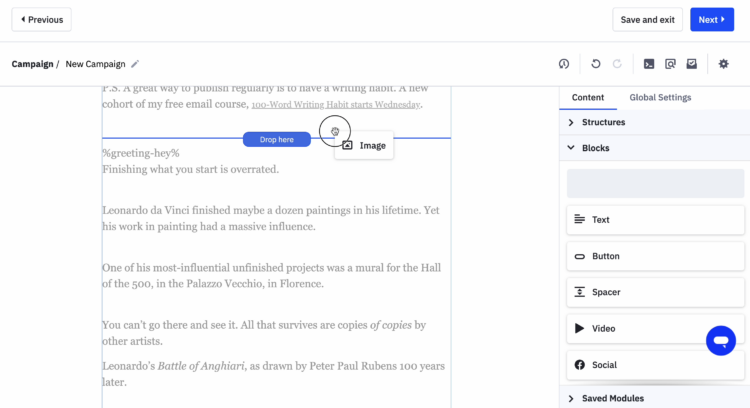
By contrast, with Kit’s editor, it’s very easy to make a simple email, and even drag-and-drop an image right into a block of text.
I stay with ActiveCampaign despite a less-than-ideal campaign editor experience, in part because I was able to build the RSS-triggered campaign system I talked about earlier. Now I create most of my emails in WordPress, through my newsletter creation system without having to deal with the campaign editor.
Question #3: Editing emails within an automation
The experience of editing emails within an automation on ActiveCampaign involves more friction than I would like. This seems to be a compromise which comes along with their versatile automation editor.
This is the most cumbersome when editing, say, an email course, where I simply have a series of emails I want to be able to rapidly switch amongst and make edits to.
My options are either to, from within the automation, click on each email, then click through to the campaign editor, or, go to the Automation Messages flow and open each email in a separate tab.
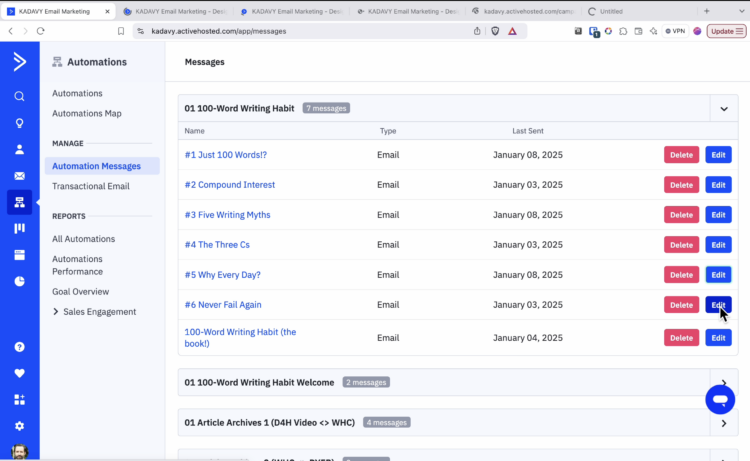
By contrast, Kit has a great experience for editing an email course. You can easily click amongst all emails in the course.
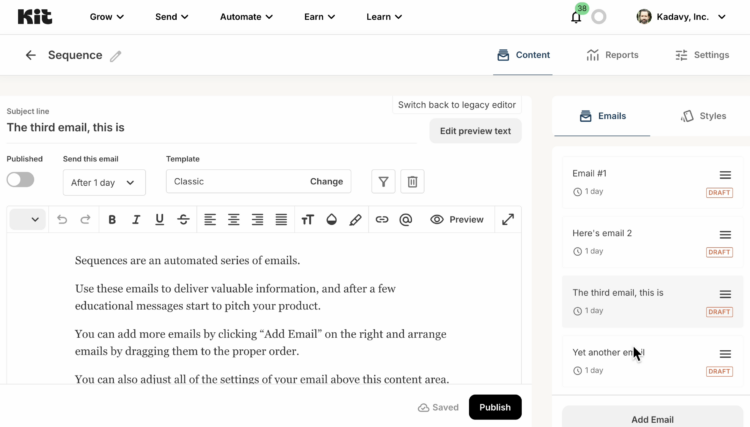
This isn’t enough to make me switch away from ActiveCampaign, because I don’t that often edit email courses. It’s a little extra clicking around to get one set up, but once I set it, I forget it.
ActiveCampaign alternatives
Here are a few ActiveCampaign alternatives, depending upon your needs.
- For e-commerce: Check out Klaviyo. They have deep integration with e-commerce platforms, such as Shopify, and pre-built automations for common scenarios.
- For creators: No surprise, take a look at Kit. They have a quicker setup with simpler automations, and lots of built-in tools for creators, such as lead-magnet landing pages and monetizations, though with fewer integrations and no CRM.
- For enterprise: Check out Salesforce Marketing Cloud. Their Salesforce integration is native, and this tool will help you craft sophisticated customer journeys with rich data, but at a premium in cost and complexity.
ActiveCampaign pricing (vs. alternatives)
Price isn’t as important as having the right email marketing tool for your business, but as you can see, AC has competitive pricing, with lots of different levels of service, to customize for your business.
| Starter | Plus | Pro | Enterprise | |
| ActiveCampaign | $15 | $49 | $79 | $145 |
| Email + SMS | Customer Data Platform | |||
| Klaviyo | $30 | $30 | $500 | |
| Newsletter | Creator | Creator Pro | ||
| Kit | Free | $29 | $59 | |
| Starter Suite | Growth Edition | Advanced Edition | ||
| Salesforce Marketing Cloud | $25 | $1,500 | $3,250 | |
| Pricing at exactly 1,000 subscribers | ||||
ActiveCampaign free trial: free for 14 days, then 20% off!
There’s no substitute for actually trying an email marketing platform, to see if you like the experience and how the features fit your business, so get a free trial through this link. After a 14-day trial, you’ll get 20% off annual plans.


